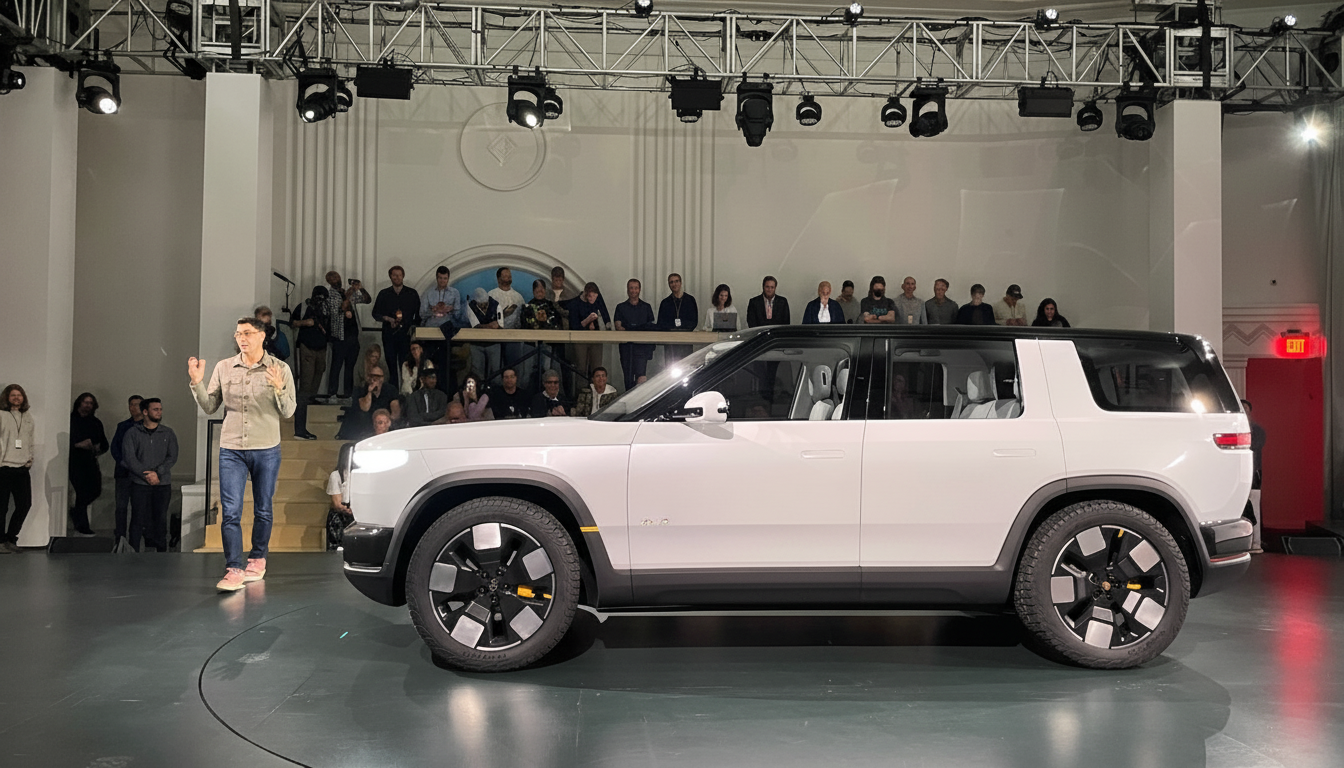Rivian founder and CEO RJ Scaringe is assuming direct control of the company’s marketing and creative organizations in a reorganization that was announced internally on Wednesday, according to sources familiar with the changes.
The reorganization also involves a cutback in headcount of nearly 4.5%, or more than 600 positions, as Rivian redoubles its focus on cost discipline and a leaner go-to-market plan.
- Why Scaringe Is Handling the Marketing Himself
- Restructuring For Simplification Of Customer Experience
- The Buildup for R2 Intensifies Amid Market Headwinds
- R2 Positions Itself as Rivian’s First True Volume Bet
- Cost Discipline Meets Brand Building in Leaner Push
- What to Watch Next as Rivian Preps the R2 Launch

Scaringe framed the moves in a company email viewed by employees as necessary to scale profitably in a more challenging operating environment. In addition to the leadership change, Rivian is bringing vehicle operations into its service division and shifting delivery and mobile operations over to sales, making it a single owner-facing touchpoint from the order until the handoff.
Why Scaringe Is Handling the Marketing Himself
Handing marketing and creative over to your CEO is a high-stakes wager on coherence and velocity. The R2 is Rivian’s first real volume play — priced to sell to a vastly bigger audience than the premium-etched R1T and R1S — and its fate rests on a crystal-clear brand promise, one from product positioning through how it’s retailed. Consolidating brand, product, and customer narrative under a single leader, Rivian is ultimately looking to get on message, media buys, and launches faster with less friction.
It’s also a coming back to basics. Scaringe has long been Rivian’s chief storyteller, pushing the design and the adventure credentials and a software-driven ownership experience. Putting the creatives under the CEO could drive down acquisition costs, speed up those content cycles, and sew all of those updates to hardware, software, and services into a single marketing push — which is crucial in an EV market where a slate of purchasing decisions already get muddied by factors like perceived value or trust.
Restructuring For Simplification Of Customer Experience
Rivian’s reorg effectively does away with handoffs that can annoy purchasers. With vehicle operations built within the service, it brings pre-delivery quality and over-the-air readiness under one roof and early ownership support. Moving delivery and mobile operations into sales centralizes accountability for the end-to-end journey by a single team, cutting cycle times and designed to bring about one line of accountability.
For an automaker that sells its cars directly to consumers, that consolidation is a strategic one. It allows for more intelligent staffing, more consistent delivery windows, and greater use of remote diagnostics — all areas that Rivian is already heavily investing in. The aim: less surprise for customers and lower internal costs per delivery.
The Buildup for R2 Intensifies Amid Market Headwinds
The company’s reset is coming at a time of escalating headwinds. Rules for federal EV tax credits have blown around as battery-sourcing rules evolved, knocking demand for certain trims across the industry, according to Treasury guidance. Recent EV and battery material tariff hikes have further muddled cost structures too. Add in higher interest rates and a more price-sensitive buyer, and it’s plain that the argument for a tighter message and leaner operations is unassailable.

Market growth is still real but more lopsided. Cox Automotive analysts estimate EV share of U.S. new-vehicle sales was settling into the high single digits after a spurt of early adopters, and that growth had normalized. As a brand, this dynamic really only favors those brands that can well communicate total cost of ownership, software features and charging convenience, resale confidence — where the story marketing has got to land for R2.
R2 Positions Itself as Rivian’s First True Volume Bet
Rivian has said the R2 will aim for a more mass-market price (somewhere in the mid-$40,000 range at launch), broadening its market potential far beyond that of the R1 family. The company had previously stated that it would produce R2 at its Normal, Illinois, facility in order to speed up timing and lower capital requirements, leveraging lessons learned from R1 along with its commercial vans.
Execution will matter. Rivian made more than 57,000 vehicles in 2023, according to company filings, a sign of manufacturing momentum but also an indication of the challenge behind achieving sustainable gross margins. The R2 program was aimed to have a simplified architecture and more efficient supply chain in place from day one, all in the service of improving unit economics.
Cost Discipline Meets Brand Building in Leaner Push
The 4.5% reduction in the workforce extends a multiseasonal roil designed to streamline and extend runway. Less overhead — and creativity led by the CEO — signal a move from awareness to conversion marketing: targeted content, owned channels, and community-driven tactics that amplify advocacy as they bring costs down.
If successful, Rivian could compress the time from product update to marketing activation and improve order conversion while minimizing post-delivery friction that erodes margins. The combined service and sales model is expected to further equip the company with a richer data set across the ownership lifecycle, increasing upsell, retention, and software feature adoption.
What to Watch Next as Rivian Preps the R2 Launch
Key signals to watch will be R2 pricing and configuration strategy, reservation traction, and any visible change in Rivian’s creative voice under Scaringe.
Operationally, watch for delivery cycle times, service metrics, and margin trajectory as the reorg beds in. In a market that punishes execution gaps with the swiftness of a fired bullet, putting the brand story squarely on the CEO’s shoulders is just about as high-stakes — if demanding — a step ahead of Rivian’s most important launch yet.

